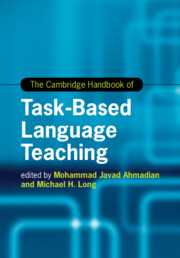Book contents
- The Cambridge Handbook of Task-Based Language Teaching
- Cambridge Handbooks In Language And Linguistics
- The Cambridge Handbook of Task-Based Language Teaching
- Copyright page
- Dedication
- Contents
- Figures
- Tables
- Contributors
- Preface The Origins and Growth of Task-Based Language Teaching
- Part I The Rationale for Task-Based Language Teaching
- Part II Tasks and Needs Analysis
- Part III The Task Syllabus and Materials
- Part IV Methodology and Pedagogy
- Part V Task-Based Language Teaching with School-Age Children
- Part VI The Teacher in Task-Based Language Teaching
- 12 Teacher Preparation and Support for Task-Based Language Teaching
- 12A Connecting Teacher Training to Task-Based Language Teaching Implementation
- 12B Training for Tasks the Cooperative Way
- Part VII Task-Based Assessment and Program Evaluation
- Part VIII Research Needs and Future Prospects
- Index
- References
12A - Connecting Teacher Training to Task-Based Language Teaching Implementation
A Case Study of Preservice Teachers in Honduran Bilingual Schools
from Part VI - The Teacher in Task-Based Language Teaching
Published online by Cambridge University Press: 19 November 2021
- The Cambridge Handbook of Task-Based Language Teaching
- Cambridge Handbooks In Language And Linguistics
- The Cambridge Handbook of Task-Based Language Teaching
- Copyright page
- Dedication
- Contents
- Figures
- Tables
- Contributors
- Preface The Origins and Growth of Task-Based Language Teaching
- Part I The Rationale for Task-Based Language Teaching
- Part II Tasks and Needs Analysis
- Part III The Task Syllabus and Materials
- Part IV Methodology and Pedagogy
- Part V Task-Based Language Teaching with School-Age Children
- Part VI The Teacher in Task-Based Language Teaching
- 12 Teacher Preparation and Support for Task-Based Language Teaching
- 12A Connecting Teacher Training to Task-Based Language Teaching Implementation
- 12B Training for Tasks the Cooperative Way
- Part VII Task-Based Assessment and Program Evaluation
- Part VIII Research Needs and Future Prospects
- Index
- References
Summary
This case study describes the implementation of a task-based teacher training program for novice English teachers at a network of bilingual schools in Honduras. Teachers’ experiences in the training and implementation of teacher-designed TBLT lessons were examined through written reflections, interviews and video-recorded classroom observations. Findings demonstrated variability in TBLT implementation that was connected with teachers’ training experiences. Teachers highlighted the utility of the student-centered, task-based nature of the training but took issue with the lack of concrete resources provided. The findings have implications for language teachers, teacher trainers, and administrators in similar language programs worldwide.
Keywords
- Type
- Chapter
- Information
- The Cambridge Handbook of Task-Based Language Teaching , pp. 463 - 477Publisher: Cambridge University PressPrint publication year: 2021

